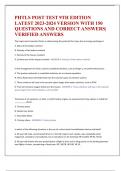PHTLS POST TEST 9TH EDITION
LATEST 2023-2024 VERSION WITH 150
QUESTIONS AND CORRECT ANSWERS|
VERIFIED ANSWERS
The single most important factor in determining the potential for injury due to energy exchange is:
A. Mass of the bodies involved
B. Velocity of the bodies involved
C. Density of the tissues involved
D. Surface area of the impact involved - ANSWER-B. Velocity of the bodies involved
In the management of shock, isotonic crystalloid solutions, such as Ringer's, are preferred because:
A. The protein molecules in crystalloid solutions act as volume expanders
B. These fluids draw interstitial fluid into the vascular space to enhance volume
C. These solutions will stay in the vascular space longer than water solutions, such as D5W
D. Their pH enhance oxygen delivery to the tissues - ANSWER-C. These solutions will stay in the vascular
space longer than water solutions, such as D5W
The phase of an explosion, or blast, in which hollow organs are squeezed and may rupture is called the
__________ phase.
A. Tertiary phase
B. Quaternary phase
C. Secondary phase
D. Primary phase - ANSWER-D. Primary phase
In which of the following situations is the use of a short spinal immobilization device indicated?
A. 28 year old male, unrestrained driver in a frontal impact crash. Awake, asks repeatedly what
happened, complains of a headache, has a hematoma on his forehead. BP 122/84, HR 92, VR 20.
B. 40 year old female who was pushed down a flight of stairs and is lying prone on the landing between
two flights of stairs, complaining of back pain. BP 118/78, HR 100, VR 20.
,C. 17 year old female, restrained driver in a frontal impact crash. Awake, pale and diaphoretic,
complains of upper right quadrant abdominal pain. BP 100/70, HR 108, VR 20. D. None of the above -
ANSWER-D. None of the above
Which of the following is 100% accurate in verifying endotracheal tube placement?
A. Pulse oximetry
B. End-tidal capnometry
C. Syringe aspiration
D. None of the above - ANSWER-D. None of the above
When utilizing percutaneous transtracheal ventilation, the correct ration of lung inflation to lung
inflation time, in seconds, is:
A. 1:4
B. 1:5
C. 1:2
D. 2:2 - ANSWER-A. 1:4
Which of the following procedures is considered an essential airway skill?
A. Needle cricothyroidotomy
B. Endotracheal intubation
C. Insertion of an oropharyngeal airway
D. Retrograde endotracheal intubation - ANSWER-C. Insertion of an oropharyngeal airway
Pericardial tamponade is most likely to occur in which of the following situations?
A. Stab wound to the chest
B. Fall from a height
C. Frontal impact vehicle crash
D. Gunshot wound to the chest - ANSWER-A. Stab wound to the chest
Which of the following is the preferred site for needle decompression of a tension pneumothorax?
,A. 4th intercostal space, midclavicular line, just over the top of the 5th rib
B. 4th intercostal space, midclavicular line, just below the 4th rib
C. 2nd intercostal space, midclavicular line, just over top of the 3rd rib
D. 2nd intercostal space, midclavicular line, just below the 2nd rib - ANSWER-C. 2nd intercostal space,
midclavicular line, just over top of the 3rd rib
Which of the following is the mechanism by which pulmonary contusion interferes with oxygenation?
A. Inability to generate negative intrapleural pressure
B. Decrease in vital capacity due to collapse of the flail segment
C. Increased intrathoracic pressure
D. Blood and fluid in the alveoli and interstitial spaces of the lung - ANSWER-D. Blood and fluid in the
alveoli and interstitial spaces of the lung
Your patient is a 55 year old male who was struck in the right side of the chest with a piece of steel pipe.
He presents with uncooperative behavior, his skin is pale and moist, the ventilatory rate is 32, there is a
weak radial pulse of 112, and breath sounds are decreased on the right side. The trachea is midline and
jugular veins are flat while the patient is supine. There is isolated crepitus over the 4th and 5th ribs in
the midaxillary line on the patient's right side. Based on the mechanism of injury and the assessment
findings, which of the following is the most likely cause of the patient's signs and symptoms?
A. Tension pneumothorax
B. Simple pneumothorax
C. Pulmonary contusion
D. Hemothorax - ANSWER-D. Hemothorax
Deterioration of ventilation and oxygenation after inflation of a PASG in a patient who has sustained a
high-pressure compression injury of the abdomen, such as a sudden deceleration with the lap belt
placed across the abdomen, most likely represents which of the following injuries?
A. Abdominal aortic aneurysm
B. Ruptured diaphragm
C. Ruptured esophagus
D. "Paper bag" syndrome of the lungs - ANSWER-B. Ruptured diaphragm
, Which of the following is NOT a component of the Fick Principle?
A. Adequate number of platelets in the blood
B. Oxygenation of red blood cells
C. Transportation of red blood cells to the tissues of the body
D. Off-loading oxygen from the red blood cells to the tissues - ANSWER-A. Adequate number of platelets
in the blood
One of the earliest signs of hypovolemic shock is:
A. Hypotension
B. Bradycardia
C. Anxiety
D. Reduced urine output - ANSWER-C. Anxiety
Which of the following characterizes the washout phase of shock?
A. Systemic acidosis
B. Localized tissue acidosis
C. Edema
D. Reduced capillary blood flow - ANSWER-A. Systemic acidosis
A trauma patient who has fallen 20 feet from an apartment balcony is alert with warm, dry, pink skin,
with normal capillary refilling time to the lower extremities, and is hypotensive. The upper extremities
are cool, pale and diaphoretic. Which of the following injuries should be suspected?
A. Aortic dissection
B. Liver laceration
C. Fractured pelvis
D. Spinal cord injury - ANSWER-D. Spinal cord injury
Which of the following is a limitation of prehospital fluid resuscitation of the patient in hemorrhagic
shock?




